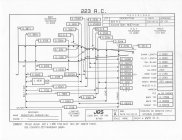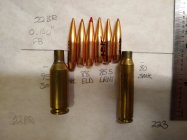Thank you ahead of time for your information.
I have been reading as much as I can from past posts as well as the cartridge guide on this subject and have a good idea of numbers, but want to finalize my specs before I order the reamer and barrel. Will be for IBS competition shooting.
From what I have gathered 1:7 up to 1:7.5 twist barrels are ideal with the 22br velocities with maybe a 1:7.2 being perfect? This will be a button rifle barrel per request of the owner and a 1:7 is available from that particular maker...if we are leaving something significant on the table I will be happy to convince the owner of the rifle to go a different way.
Shooting will be done in temps above 60F for the most part, but not likely too far below that...highs in the 90's.
I will be ordering my reamer from JGS so a specific freebore length would be great. I know PTG has a reamer set up for this cartridge and 0.169 was listed a few times as well as up to 0.180-.185.
Thanks again,
Mike
I have been reading as much as I can from past posts as well as the cartridge guide on this subject and have a good idea of numbers, but want to finalize my specs before I order the reamer and barrel. Will be for IBS competition shooting.
From what I have gathered 1:7 up to 1:7.5 twist barrels are ideal with the 22br velocities with maybe a 1:7.2 being perfect? This will be a button rifle barrel per request of the owner and a 1:7 is available from that particular maker...if we are leaving something significant on the table I will be happy to convince the owner of the rifle to go a different way.
Shooting will be done in temps above 60F for the most part, but not likely too far below that...highs in the 90's.
I will be ordering my reamer from JGS so a specific freebore length would be great. I know PTG has a reamer set up for this cartridge and 0.169 was listed a few times as well as up to 0.180-.185.
Thanks again,
Mike












